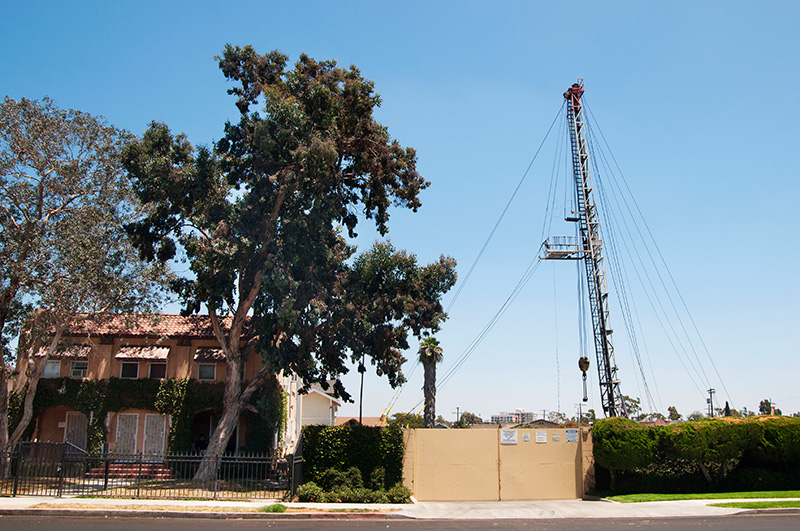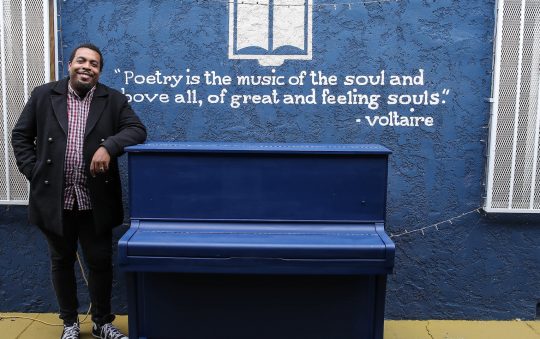
A residential home is right next to the Jefferson drill site. Many neighborhood residents complain of dangerous toxins that seep into their homes, causing adverse medical conditions. (Courtesy Photo)
South Los Angeles environmental activists and advocates are celebrating after the City Planning Department mandated stronger protections for oil drilling sites in their community.
According to the department’s October 13 letter to Sentinel Peak Resources, site operators, the community contended its operation “was a constant nuisance to the neighborhood with its noise, traffic congestion, odors, loitering, and mishandling of hazardous materials.”
After years of protests, organizing, and hearings during which the community complained of health concerns, they won protective measures with built-in accountability for the Jefferson oil drilling site.
That includes 24/7 video monitoring of the drilling site, unprecedented air quality monitoring that’s publicly accessible, and vibration monitoring, indicated Earthjustice.
Sentinel Peak Resources must stop using diesel rigs, and install noise monitors, among other things, further indicated environmental advocates.
The order stems from a petition that Earthjustice, a non-profit environmental law firm, filed in June 2016 on behalf of Redeemer Community Partnership, which works to create safe, healthy, opportunity-rich communities in South L.A.
“We are relieved by the city’s decision because this decision extends protections they gave to wealthier West L.A. neighborhoods decades ago,” said Richard Parks, president of RCP.
For instance, drill sites in West Los Angeles were enclosed two decades ago, he said. “The community has been working together for five years to try and get these protections extended to South Los Angeles,” Parks stated.
According to Earthjustice, Sentinel Peak Resources repeatedly violated rules outlined in approval for its operation of the site, including city permit violations, traditions of operations violations, and Air Quality Management District violations.
For years, advocates charged, it was so difficult to do anything about the poorly run site, because politicians really wanted oil company money, and didn’t want to protect the community’s health.
“For too long, South L.A. has had representation that was willing to trade our health for corporate wealth, and we have new political leadership in Councilman Marqueece Harris-Dawson (8th District), and he has made a decision to stand with the community for residents’ health and safety,” Parks said.
Harris-Dawson’s courage has been very significant in winning the new protections, as well as the community’s own perseverance, Parks noted.
Union Oil bought and demolished homes in the old, residential neighborhood in the 1960s, Parks began with a historical glimpse of the struggle.
Through a technique called horizontal drilling, Union Oil placed a spider’s web of wells that extend out, according to Parks. At first, the oil and gas was easy to extract, but that’s long been taken out, he said.
To get at the remaining hydrocarbons, operators of the site has resorted to ever more extreme extraction techniques, such as acidization, Parks continued.
“What they will do is bring tens of thousands of gallons of highly corrosive, highly toxic, highly carcinogenic endocrine-disrupting chemicals (that disrupt reproductive health across generations,” Parks explained. He said the oil company pumps the acid into the ground, underneath the neighborhood.
“We have seen four tanker trunks, filled with acid, on the site, at one time. Each tanker truck carries 5,000 gallons of this toxic acid … and we have photographs of their workers, standing in head-to-toe protective gear, behind red danger tape, while literally, 10 feet away, on the other side of the wall, there are residents’ windows, and those residents receive no warning about what’s happening,” Parks stated.
He said photos show that fugitive fumes from the acid have been so intense, that plants on the downwind corner of the drill site have been chemically burned and killed.
Their door-to-door talks with residents revealed horrific stories, Parks said. “One dad told me about how closed windows could not keep out the diesel odors, the petroleum odors from his daughter’s windows,” Parks said.
The family ultimately moved out for fear of her health and safety. In addition, he said, people’s homes and cars parked on the streets have been sprayed with oil.
“You can just imagine, there are neighborhoods in this city where that would never be tolerated, but that kind of reckless disregard for residents has been allowed and tolerated here for decades,” stated Parks.
The city’s mandate validates the South L.A. community’s experiences and concerns, and they are really thankful for Harris-Dawson, he reiterated.
Harris-Dawson applauded the city’s findings and strong stand to protect residents of South L.A.
“I’ve personally visited this site several times, and I personally know residents who have been affected by the drilling operation for years. There are 36 oil wells on less than two acres, right in the middle of a residential neighborhood,” he stated.
“While there is similar oil drilling in other neighborhoods, for years the Jefferson Drill Site operated without due regard to its neighbors. I’m glad to see that we are requiring a permanent, enclosed structure like I see in other drill sites around the city. There is a robust list of other conditions that should not be reserved for more affluent communities, but all communities where drilling takes place. The Jefferson Drill Site may very well represent the most stringent set of operating conditions on a drill site in the country, and I expect nothing less in South Los Angeles, Harris-Dawson continued.
As for next steps, neighbors can never let their guard down, and must remain vigilant, watch corporations and accept responsibility to hold them accountable, Parks said.






